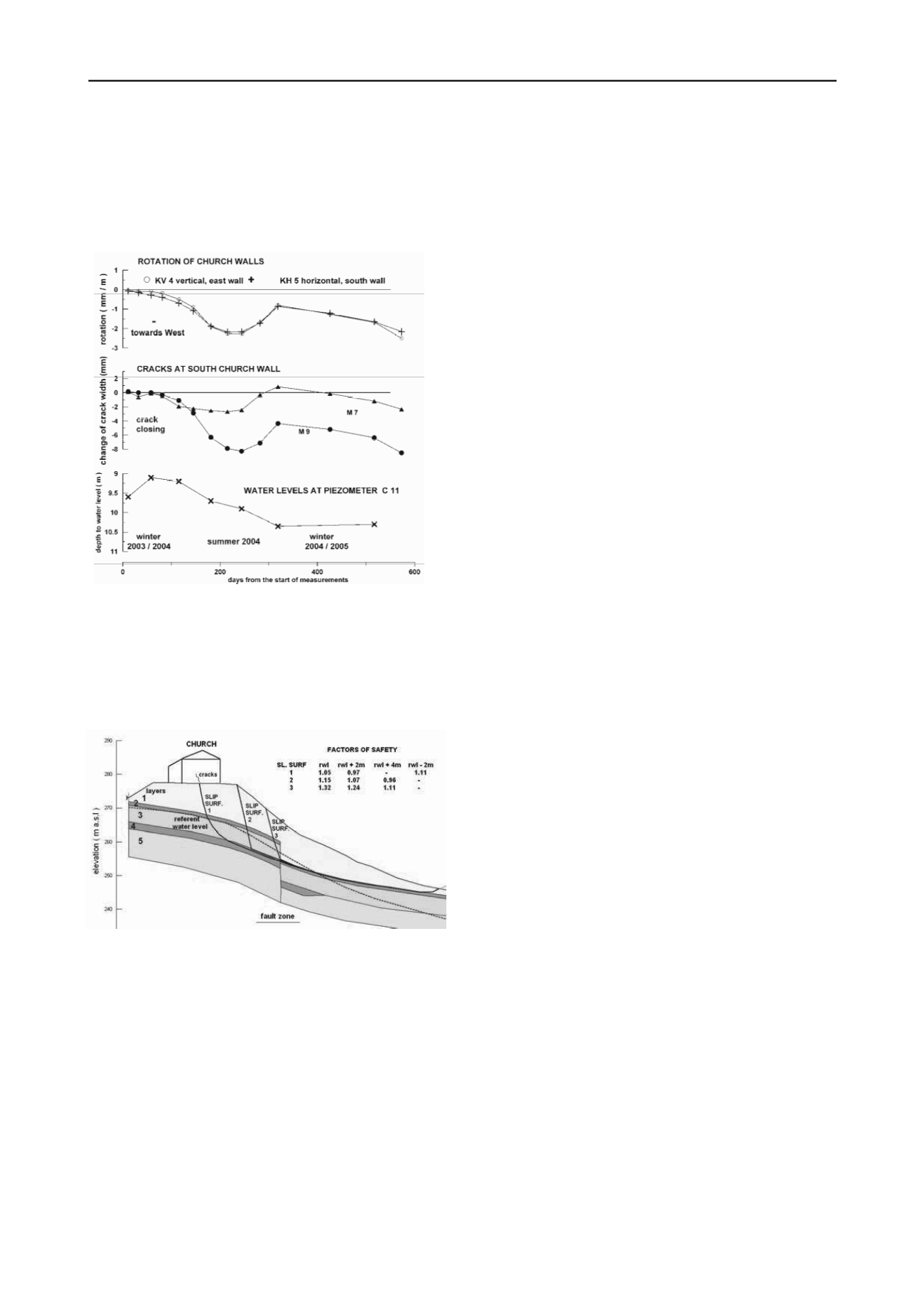
554
Proceedings of the 18
th
International Conference on Soil Mechanics and Geotechnical Engineering, Paris 2013
The whole situation at the site can be described as unstable
(labile) or at the limits of equilibrium. However, even the recent
observations have shown that the net effect of “swaying” are
slow irreversible displacements in direction of sliding, with
cumulative displacements of 4 - 8 mm in last several years.
Also, some cracks have opened at the western part of church
which was “quiet” during the intensive monitoring period.
Figure 7. Monitoring of church wall displacements.
4.2
Stability analyses
The presented charts using the RNK method describe the
landslide underground conditions and enable the construction of
geotechnical models for engineering analyses in various cross-
sections.
Figure 8. Model and results of stability analyses
The cross-section A-A (shown in Figure 4) which includes
the church ridge and downhill slope was used for common
stability analyses (Spencer limit equilibrium method). The
layers corresponding to the geotechnical zones in Figure 4, with
several slip surfaces in the layers of lowest strength are shown
in Figure 8. The strength parameters taken in analyses were:
cohesion c’=0 kPa (for all layers), and friction angle
’ = 28,
24, 30º (for zones 1, 2-4, 5, respectively). The minimal friction
angle
’ = 24º corresponds to the results of ring shear test and
correlation chart. The ground water levels were varied few
meters from referent level to estimate the influence of possible
variations.
This type of numerical modelling might be understood as
too crude or too approximate for such a complex geologic
situation at the site. However, the results (factors of safety)
reveal that the established geotechnical model (with sequence of
layers, friction angles, water levels) and slip surfaces respecting
the established weakest zones, demonstrate the unstable
conditions - by obtaining the safety factors near Fs = 1. Also
shown is the expected trend of lowering of safety factor with
rise of ground water level.
These rough estimates are demonstrated for static
conditions, implying that even the low or moderate seismic
activity can significantly reduce slope stability.
5 CONCLUSION
The interaction of engineering geology and geotechnics in the
process of designing geotechnical structures is very important.
In the study of landslides or stability levels of natural and
artificially shaped slopes, unequivocal results can be obtained
by the correlation of formations. This can be done by
introducing the reference level of correlation (RNK-method)
and by looking for the zone of minimum shear strength in the
engineering-geological and geotechnical correlation column.
The creation of reliable geotechnical model is a center of
this process, and it is crucial for the quality of the entire project.
The correlation of the friction angle with the liquid limit or
plasticity index is suggested for correct assessment of shear
strength.
6 REFERENCES
GZ. 2005.
The catalogue of earthquakes in Croatia
, Department of
geophysics, Faculty of Science, University of Zagreb
Ivšić, T., Ocvirk, E., Pavlin, Ž. 2005. Geotechnical Aspects of Small
Retention Dam Vir in Croatia.
Proc.
Ninth International
Symposium on Water Management and Hydraulic Engineering
.
Nachtnebel H.P. (ed.). Ottenstein : BOKU-University of Natural
Resources and Applied Life Sciences, 2005. 221-228
Jurak V., Ortolan Ž., Slovenec D. & Mihalinec Z. 2004. Verification of
Engineering-Geological / Geotechnical Correlation Column and
Reference Level of Correlation (RNK) Method by Observations in
the Slip-Plane Zone.
Geologia Croatica
57(2): 191-203
Mihalinec Z. & Stanić B. 1991. Three-dimensional slide analysis
procedure (in Croatian).
Građevinar
, 42(9): 441-447
Ortolan Ž. 1990. Le rôle de la methode de correlation dans la
determination des zones de parametres minimaux de resistance au
cisaillement.
Proc. of the Sixth Int. Congress IAEG, 6-10 Aug.
1990, Amsterdam.
Balkema: 1675-1679
Ortolan Ž. 1996.
The creation of a spatial engineering-geological model
of deep multi-layered landslide on an example of the Podsused
landslide in Zagreb
(in Croatian). PhD Thesis. University of Zagreb
Ortolan Ž. 2000. A Novel Aproach to the Modeling of Deep Complex
Landslides with Several Sliding Planes. In E. Bromhead, N. Dixon,
M.I. Ibsen (eds)
Landslides in Research, Theory and Practice.
3:
1153-1158, Thomas Telford
Ortolan Ž. & Mihalinec, Z. 1998. Plasticity index - Indicator of shear
strength and a major axis of geotechnical modeling. In B. Marić et
al. (eds)
Geotechnical hazards, Proc. of the XI-th Danube-
European conference on soil mechanics and geotechnical
engineering, Poreč, Croatia, 25-29 May 1998.
Balkema: 743-750
Ortolan Ž., Mihalinec, Z., Stanić, B. & Pleško, J. 1995. Application of
Repeated Photogrammetric Measurements at Shaping Geotechnical
Models of Multi-layer Landslides.
Proc. 6th Int. Symp. on
Landslides
. Balkema: 1685-1691
Ortolan Ž., Zlatović S. & Vrkljan I. 2009. Geotechnical 3D modeling in
soft rocks using the RNK method.
Rock engineering in difficult
ground conditions – soft rocks and karst. Proc. of the reggional
symp. of the ISRM, Eurock 2009, Dubrovnik, Croatia, 29-31
october 2009.
CRC Press, Taylor & Francis Group: 489-494.


